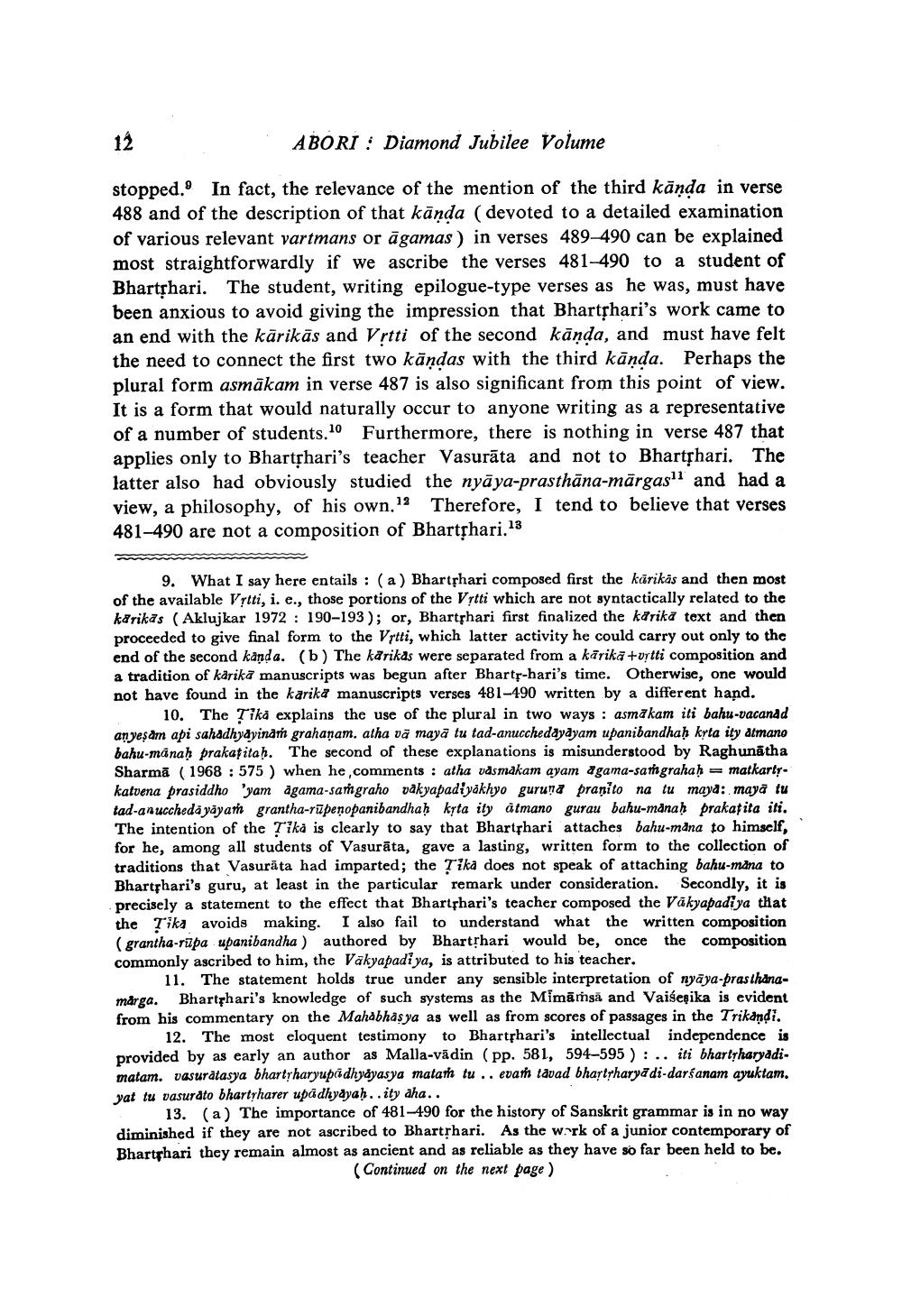Book Title: Concluding Verses Of Bhartrharis Vakya Kanda Author(s): Ashok Aklujkar Publisher: Ashok Aklujkar View full book textPage 4
________________ 12 ABORI : Diamond Jubilee Volume stopped. In fact, the relevance of the mention of the third kāņda in verse 488 and of the description of that kāņda (devoted to a detailed examination of various relevant vartmans or āgamas ) in verses 489–490 can be explained most straightforwardly if we ascribe the verses 481-490 to a student of Bhartphari. The student, writing epilogue-type verses as he was, must have been anxious to avoid giving the impression that Bhartshari's work came to an end with the kārikās and Vrtti of the second kānda, and must have felt the need to connect the first two kāņdas with the third kāņda. Perhaps the plural form asmākam in verse 487 is also significant from this point of view. It is a form that would naturally occur to anyone writing as a representative of a number of students.10 Furthermore, there is nothing in verse 487 that applies only to Bhartphari's teacher Vasurāta and not to Bhartphari. The latter also had obviously studied the nyāya-prasthāna-mārgas" and had a view, a philosophy, of his own." Therefore, I tend to believe that verses 481-490 are not a composition of Bhartshari.13 9. What I say here entails : (a) Bharthari composed first the kärikäs and then most of the available Vrtti, i. e., those portions of the Vitti which are not syntactically related to the karika's (Aklujkar 1972 : 190-193); or, Bharthari first finalized the karika text and then proceeded to give final form to the Vrtti, which latter activity he could carry out only to the end of the second kanda. (b) The karikas were separated from a kārika +vytti composition and a tradition of karika manuscripts was begun after Bhartr-hari's time. Otherwise, one would not have found in the karika manuscripts verses 481-490 written by a different hand. 10. The Tika explains the use of the plural in two ways : asmakam iti bahu-vacanad anyesam api sahadhydyinam grahanam. atha va mayā tu tad-anucchedayayam upanibandhaḥ krta ity atmano bahu-manah prakafitah. The second of these explanations is misunderstood by Raghunātha Sharmā (1968 : 575 ) when he ,comments : atha vdsmakam ayam agama-sangrahaḥ = matkartykatvena prasiddho 'yam agama-samgrahovákyapadiyakhyo gurund pranito na tu maya maya tu tad-cauccheda yāyan grantha-rūpenopanibandhaḥ kȚta ity átmano gurau bahu-manaḥ prakațita iti. The intention of the Tika is clearly to say that Bhartphari attaches bahu-mana to himself, for he, among all students of Vasurāta, gave a lasting, written form to the collection of traditions that Vasurata had imparted; the Tika does not speak of attaching bahu-mana to Bharthari's guru, at least in the particular remark under consideration. Secondly, it is precisely a statement to the effect that Bharthari's teacher composed the Vakyapadi ya that the Tika avoids making. I also fail to understand what the written composition (grantha-rupa upanibandha) authored by Bhartshari would be, once the composition commonly ascribed to him, the Vakyapadi ya, is attributed to his teacher. 11. The statement holds true under any sensible interpretation of nyāya-prasthanamärga. Bhartphari's knowledge of such systems as the Mimāmsä and Vaiseçika is evident from his commentary on the Mahabhas ya as well as from scores of passages in the Trikandi. 12. The most eloquent testimony to Bharthari's intellectual independence is provided by as early an author as Malla-vādin (pp. 581, 594-595 ):.. iti bhartyharyadi. matam. vasuratasya bhartyharyupadhyayasya matam tu.. evar lavad bhartyharyadi-darśanam ayuktam. yat tu vasurato bhartyharer upådhyayah..ity aha.. 13. (a) The importance of 481-490 for the history of Sanskrit grammar is in no way diminished if they are not ascribed to Bhartphari. As the work of a junior contemporary of Bhartghari they remain almost as ancient and as reliable as they have so far been held to be. (Continued on the next page )Page Navigation
1 2 3 4 5 6 7 8 9 10 11 12 13 14 15 16 17 18
